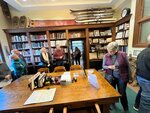
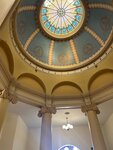
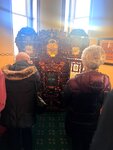
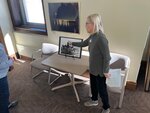
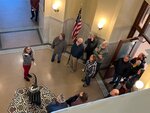
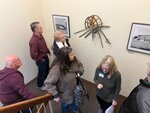
The doors to historic Hastings City Hall were open for tours January 19 as part of the Downtown Business Association Yeti Ice Sculpture Celebration.
It was a good opportunity to warm up after checking out the ice carving, and many people jumped at the chance to learn about the building.
The noon tour was divided into two groups, with Hastings Heritage Preservation Commission Chair Cindy Toppin guiding one group through the building and Hastings Arts & Culture Commission Chair Barb Hollenbeck taking the other, offering facts on the building and some of the local lore surrounding it.
The Hastings Arts & Culture Commission organized the event with help from the Hastings Historical Society and the Hastings Pioneer Room.
From a history standpoint, the then-Dakota County Courthouse was built at a cost of $63,000 and is the second-oldest courthouse in the state. Rutherford B. Hayes visited in 1878 when he was visiting Gen. William LeDuc, his Commissioner of Agriculture.
The building was remodeled in 1812 and the central dome was replaced with a Renaissance Michelangelo Dome with arched stained glass cover.
The building included a jail and actually housed Dakota County Courts until 1989. The City of Hastings bought the building for $350,000 in 1992 and did an extensive $2.5 million remodel. It opened as Hastings City Hall in 1992.
It was interesting to note that most on the tour were Hastings residents of all ages eager to see the building and the art that adorns its walls. The tour lasted about 40 minutes up and down staircases on either side of the two floors. The third floor is closed off, as it now contains heating, ventilation and air conditioning systems.
One of the residents on the tour recounted walking past the jail to and from school. In warmer weather, windows would be open, and he said the jail residents would yell to the kids.
“Stay in school,” they’d say.
There are historic photos of homes, the Spiral Bridge of course and a neat metal piece of Paris Pasch artwork in one stairwell. There are various sculptures, paintings and fascinating local artifacts, like the carved clock in the second floor former courtroom that was created by local physician Rudy Tan.
The Arts & Culture Commission has cataloged the 250 pieces of art in the building donated by local artists.
A second floor conference room overlooks downtown and the river a few blocks away.
“Can you imagine having a meeting here?” Toppin asked her group. “I wouldn’t get anything done. I’d always want to be there first so I can face the water.”
Organizers are hoping residents realize they can visit city hall anytime it’s open.
“This is your building. If you want to come out and look around, you certainly can. This is the City of Hastings City Hall. If you ever have any inclination afterwards to come and look at some of this art or the displays, just come right back,” said Toppin.
Many local historical artifacts are available in the volunteer-run Pioneer Room. It’s located on the first floor, right next door to Mayor Mary Fasbender’s office. It features historical records on Hastings homes, a historical photo collection, reference materials, genealogical records and newspaper archives. It’s open Mondays and Wednesdays from 9:30 a.m. – 4 p.m.
The tour was a great way to connect with the history of Hastings, and we’re excited to see more events from the Hastings Arts & Culture Commission that provide a connection to the community.